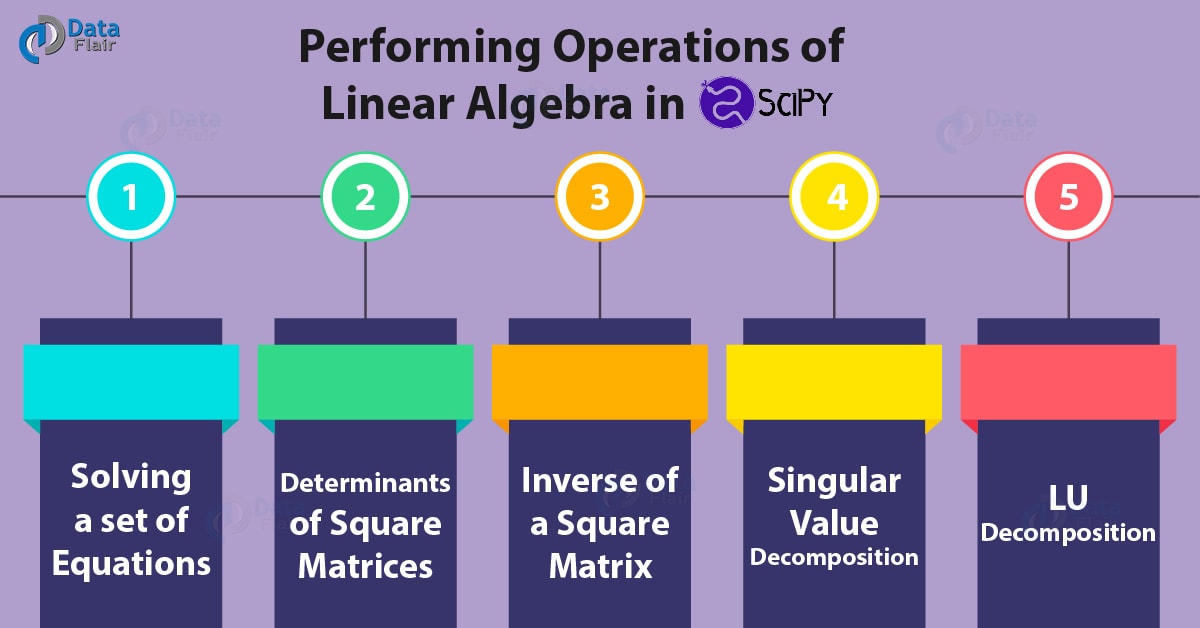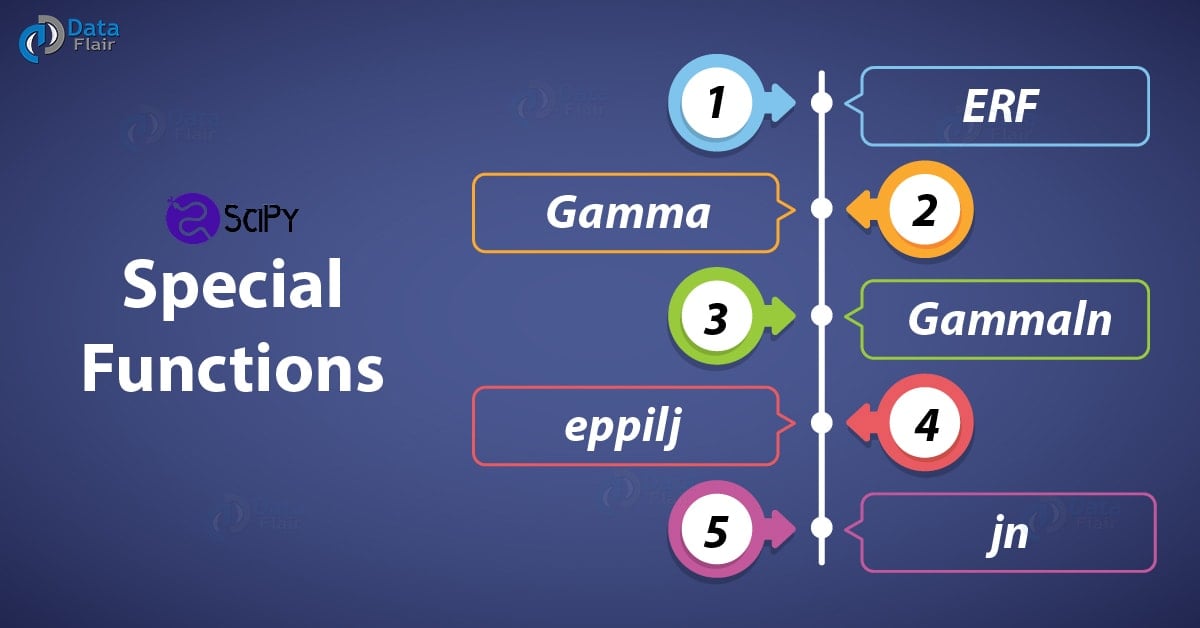Python SciPy Tutorial – What is SciPy & How to Install SciPy
Python course with 57 real-time projects - Learn Python
In our previous Python Library tutorial, we saw Python Matplotlib. Today, we bring you a tutorial on Python SciPy.
Here in this SciPy Tutorial, we will learn the benefits of Linear Algebra, Working of Polynomials, and how to install SciPy.
Moreover, we will cover the Processing Signals with SciPy, and Processing Images with SciPy.
So, let’s start the Python SciPy Tutorial.
What is SciPy in Python?
Python SciPy is open-source and BSD-licensed. You can pronounce it as Sigh Pie. Here are some shorts on it:
- Author: Travis Oliphant, Pearu Peterson, Eric Jones.
- First Release: 2001
- Stable Release: Version 1.1.0; May, 2018.
- Written in: Fortran, C, C++, Python Programming Language.
Python SciPy has modules for the following tasks:
- Optimization
- Linear algebra
- Integration
- Interpolation
- Special functions
- FFT
- Signal and Image processing
- ODE solvers
And as we’ve seen, an important feature of the NumPy module is multidimensional arrays.
This is what SciPy uses too; it will work with NumPy arrays.
SciPy Subpackages
In this Python SciPy Tutorial, we will study these following sub-packages of SciPy:
- cluster- Hierarchical clustering.
- constants- Physical constants and factors of conversion.
- fftpack- Algorithms for Discrete Fourier Transform.
- integrate- Routines for numerical integration.
- interpolate- Tools for interpolation.
- io- Input and Output tools for data.
- lib- Wrappers to external libraries.
- linalg- Routines for linear algebra.
- misc- Miscellaneous utilities like image reading and writing.
- ndimage- Functions for processing multidimensional images.
- optimize- Algorithms for optimization.
- signal- Tools for processing signal.
- sparse- Algorithms for sparse matrices.
- spatial- KD-trees, distance functions, nearest neighbors.
- special- Special functions.
- stats- Functions to perform statistics.
- weave- Functionality that lets you write C++/C code in the form of multiline strings.
Benefits of SciPy
- High-level commands and classes for visualizing and manipulating data.
- Powerful and interactive sessions with Python.
- Classes, and web and database routines for parallel programming.
- Easy and fast.
- Open-source.
How to Install SciPy?
You can use pip to install SciPy-
pip install scipy
You can also use conda for the same-
conda install –c anaconda scipy
Then, you can import SciPy as:
>>> import scipy
You will also want to interact with numpy here. Let’s import that too.
>>> import numpy
Finally, in some places, we will want to plot our results. We will use matplotlib for that; let’s import it.
>>> import matplotlib
Linear Algebra in SciPy
For performing operations of linear algebra in SciPy, we will need to import linalg from scipy-
>>> from scipy import linalg
1. Solving a set of equations
Let’s suppose this is the set of equations we want to solve-
2x+3y=7
3x+4y=10
Let’s create input and solution arrays for this.
>>> A=numpy.array([[2,3],[3,4]]) >>> B=numpy.array([[7],[10]]) >>> linalg.solve(A,B)
Output
array([[ 2.], [ 1.]])
This tells us that both equations work for x=2 and y=1. To check the results, we run the following command-
>>> A.dot(linalg.solve(A,B))-B
Output
array([[ 0.], [ 0.]])
The output confirms the correctness of the computation.
2. Determinants of Square Matrices
To calculate the determinant for a square matrix, we can use the det() method.
>>>mat=numpy.array([[8,2],[1,4]]) >>>linalg.det(mat)
Output
30.0
3. An inverse of a Square Matrix
For this, we use the inv() method.
>>> linalg.inv(mat)
Output
[-0.03333333, 0.26666667]])
4. Singular Value Decomposition
This uses the method svd().
>>> linalg.svd(mat)
Output
[-0.27652857, 0.9610057 ]]),
array([ 8.52079729, 3.52079729]),
array([[-0.9347217 , -0.35538056],
[-0.35538056, 0.9347217 ]]))
5. LU Decomposition
To carry out LU decomposition, we can use the lu() method.
>>> linalg.lu(mat)
Output
[ 0., 1.]]), array([[ 1. , 0. ],
[ 0.125, 1. ]]), array([[ 8. , 2. ],
[ 0. , 3.75]]))
Working with Polynomials in SciPy
SciPy will let us work with polynomials using the poly1d type from numpy:
>>> from numpy import poly1d >>> p=poly1d([3,2,4])
Output
3 x + 2 x + 4
>>> p*p
Output
9 x + 12 x + 28 x + 16 x + 16
>>> p(5) #Value of polynomial for x=5
Output
89
>>> p.integ(k=6) #Integration
Output
poly1d([ 1., 1., 4., 6.])
>>> p.deriv() #Finding derivatives
Output
poly1d([6, 2])
Integration with SciPy
To be able to perform integration, we will import the integrate subpackage from scipy.
>>> from scipy import integrate
The quad() function will let us integrate a function; let’s use a lambda for this.
>>> integrate.quad(lambda x:x**2,0,4) #Last two arguments are lower and upper limits
Output
(21.333333333333336, 2.368475785867001e-13)
You can use help() function to find out what else this subpackage can do for you. Here are some more functions:
- dblquad- Double integration
- tplquad- Triple integration
- nquad- n-dimensional integration
- fixed_quad- Use Gaussian quadrature of order n to integrate func(x)
- quadrature- Use Gaussian quadrature to integrate with certain tolerance
- romberg- Romberg integration
- quad_explain- Find out about quad
- newton_cotes- Weights and coefficient of error with Newton-Cotes integration
- IntegrationWarning- Warning for issues in integration
Vectorizing Functions in SciPy
The class vectorizes will let us turn a regular Python function into a vectorized function. Let’s try this out.
We’ll define a function first. If the first argument is greater than the second, it returns the sum of the two.
Otherwise, it returns the product of the two.
def addmul(a,b):
if a>b:
return a+b
else:
return a*bNow, let’s vectorize this.
>>> numpy.vectorize(addmul)([1,4,3,9],[2,3,7,8])
Output
array([ 2, 7, 21, 17])
Fast Fourier Transforms in SciPy
If you’re familiar with calculus, then there are chances are you may be familiar with Fourier Transforms.
This analysis lets you express a function as a sum of periodic components. It is possible to recover the signal from this sum.
Let’s take an example.
>>> from scipy.fftpack import fft >>> N=600 >>> T=1.0/800.0 >>> x=np.linspace(0.0,N*T,N) >>> y=numpy.sin(50.0*2.0*numpy.pi*x)+0.5*numpy.sin(80.0*2.0*numpy.pi*x) >>> yf=fft(y) >>> xf=numpy.linspace(0.0,1.0/(2.0*T),N//2) >>> import matplotlib.pyplot as plt >>> plt.plot(xf, 2.0/N * numpy.abs(yf[0:N//2]))
Output
[<matplotlib.lines.Line2D at 0x7fbb78d65210>]
>>> plt.grid() >>> plt.show()
Special Functions of SciPy
The special module holds various transcendental functions that will help us with multiple tasks in mathematics.
To import it, use the following command-
>>> from scipy import special
We make use of the various functions:
1. ERF
This function calculates the area under a Gaussean curve. We use the erf() function.
2. Gamma
This calculates the Gamma. The function for this is gamma().
3. Gammaln
This calculates the log of Gamma. We use the function gammaln().
4. eppilj
The elliptic function we have is eppilj().
5. jn
This is the Nth order Bessel function.
Processing Signals with SciPy
SciPy will also help you with signal processing. Let’s take an example.
1. Using FFT to resample
We can resample a function to n points in a time domain interval. We can use the function resample() for this.
>>> t=numpy.linspace(-10,10,200) >>> y=numpy.sin(t) >>> from scipy import signal >>> signal.resample(y,100)
Output
-0.39831149, -0.60510157, -0.72607055, -0.8701493 , -0.9336745 ,
-0.99979334, -0.98973944, -0.97222903, -0.88612051, -0.79126725,
-0.63978568, -0.48541023, -0.29029666, -0.10319111, 0.10642378,
0.29461537, 0.48697311, 0.64470867, 0.79055976, 0.89136943,
#More output here
2. Removing Linear Trends
The detrend() function will remove the linear element from the signal; this gives us a transient solution.
>>> t=numpy.linspace(-10,10,200) >>> y=numpy.sin(t)+t >>> signal.detrend(y)
Output
0.28500148, 0.18231944, 0.07991785, -0.02119249, -0.12001383,
-0.21557153, -0.30692387, -0.39317157, -0.47346689, -0.54702214,
-0.61311766, -0.67110907, -0.7204338 , -0.76061672, -0.79127497,
-0.81212183, -0.82296958, -0.82373141, -0.81442233, -0.79515896,
#More output here
Processing Images with SciPy
With SciPy, you can use ndimage to process images.
Some of the possible transitions are opening and closing images, geometrical transformation(shape, resolution, orientation), image filtering, and filters like erosion and dilation.
You can import it as:
>>> from scipy import ndimage
Let’s look at some functions we have:
1. Shift
This function will shift the image along the x and y coordinates. The function is shift(image,(x,y)).
2. Rotate
When you want to rotate your image to an angle, use the rotate(image, angle) function.
3. Zoom
With zoom(image, magnitude), you can zoom in or out on an image.
4. Median Filter
To filter an image with a Median filter, you can use median_filter(image, argument).
5. Gaussian Filter
And to filter with a Gaussian filter, you use gaussian_filter(image, argument).
6. Opening an Image in Binary
For this, you use the function binary_opening(image)
7. Closing an Image
To close this image, make a call to binary_closing(opened_image)
8. Binary Erosion
For this task, we use the function binary_erosion(image)
9. Binary Dilation
And to perform dilation, call binary_dilation(image)
Optimizing in SciPy
For algorithms that will optimize, we need the optimize package. Import it this way-
>>> from scipy import optimize
Let’s take a demo piece of code to explain this.
>>> from scipy.optimize import least_squares >>> def func1(x): return numpy.array([10 * (x[1] - x[0]**2), (1 - x[0])]) >>> input=numpy.array([2, 2]) >>> res=least_squares(func1, input) >>> res
Output
cost: 0.0
fun: array([ 0., 0.])
grad: array([ 0., 0.])
jac: array([[-20.00000015, 10. ],
[ -1. , 0. ]])
message: ‘`gtol` termination condition is satisfied.’
nfev: 4
njev: 4
optimality: 0.0
status: 1
success: True
x: array([ 1., 1.])
Working with Stats sub-packages of SciPy
The stats subpackage lets us work with statistics. Let’s take a few examples.
from scipy.stats import norm.
1. CDF Removing Linear Trends
>>> norm.cdf(numpy.array([1,-1.,3,1,0,4,-6,2]))
This function computes the cumulative distribution at the points we mention.
2. PPF
For the Percent Point Function, we use the function ppf().
>>> norm.ppf(0.5)
Output
>>> norm.ppf(2.3)
Output
3. RVS
For a random variate sequence, use rvs().
>>> norm.rvs(size=7)
Output
-1.57490259, 0.24552959])
4. Binomial Distribution
For this, we use the cdf() function from uniform.
>>> from scipy.stats import uniform >>> uniform.cdf([0,1,2,3,4,5,6,7],loc=1,scale=3)
Output
1. , 1. , 1. ])
So, this was all Python SciPy Tutorial. Hope you like our explanation.
Python Interview Questions on SciPy
- What is SciPy in Python?
- What is SciPy in Python used for?
- How to import a SciPy module into Python?
- What is SciPy optimize?
- What is the difference between NumPy and SciPy in Python?
Conclusion
Hence, in this SciPy tutorial, we studied introduction to Scipy with all its benefits and Installation process.
At last, we discussed several operations used by Python SciPy like Integration, Vectorizing Functions, Fast Fourier Transforms, Special Functions, Processing Signals, Processing Images, Optimize package in SciPy.
We work very hard to provide you quality material
Could you take 15 seconds and share your happy experience on Google








instead of trying to teach everything, you could have gone into deeper details of any one thing or two thing so that whatever people read would have learnt. this scipy tutorial is a little disappointing for me.
Nice review for numpy polynomials and scipy. Relatively hard to find scipy and panda to install on Python
Hey Ron Deep,
Glad that you liked our article. It would be great if you share this article on social media with your friends.
Nice article covering overview of SciPy. Kudos for that!